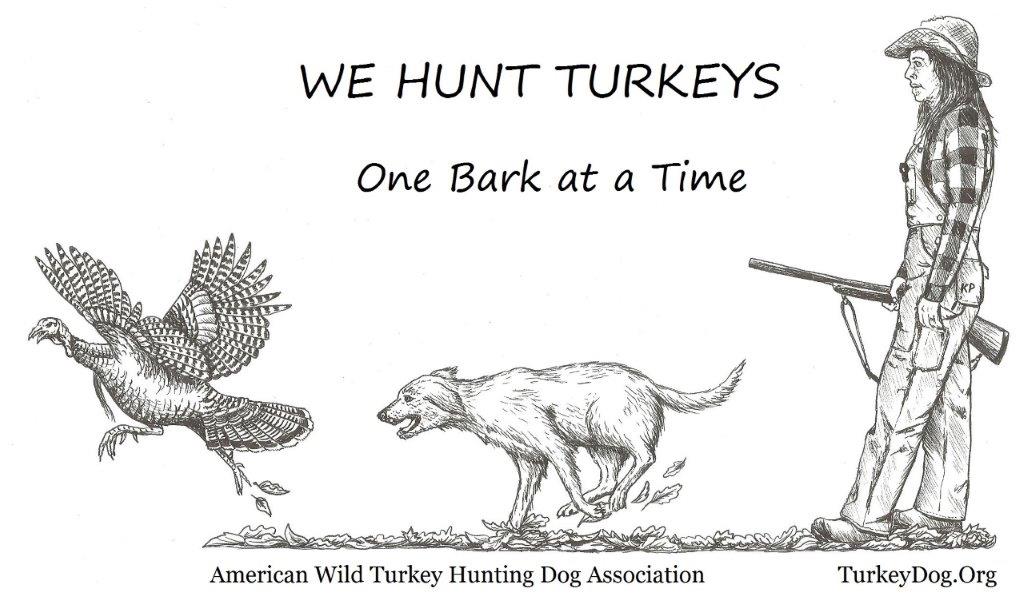 We're
always scratching for a few kernels of wisdom. We're
always scratching for a few kernels of wisdom. Send in your ponderings, opinions or predictions. |
Farmers feed the majority of turkeys and deer. But
during the
nesting season, some hens are inadvertently killed. This
turkey was
swallowed by a haybine. Five days earlier, a forage
harvester swallowed
the rest of this deer in a different field.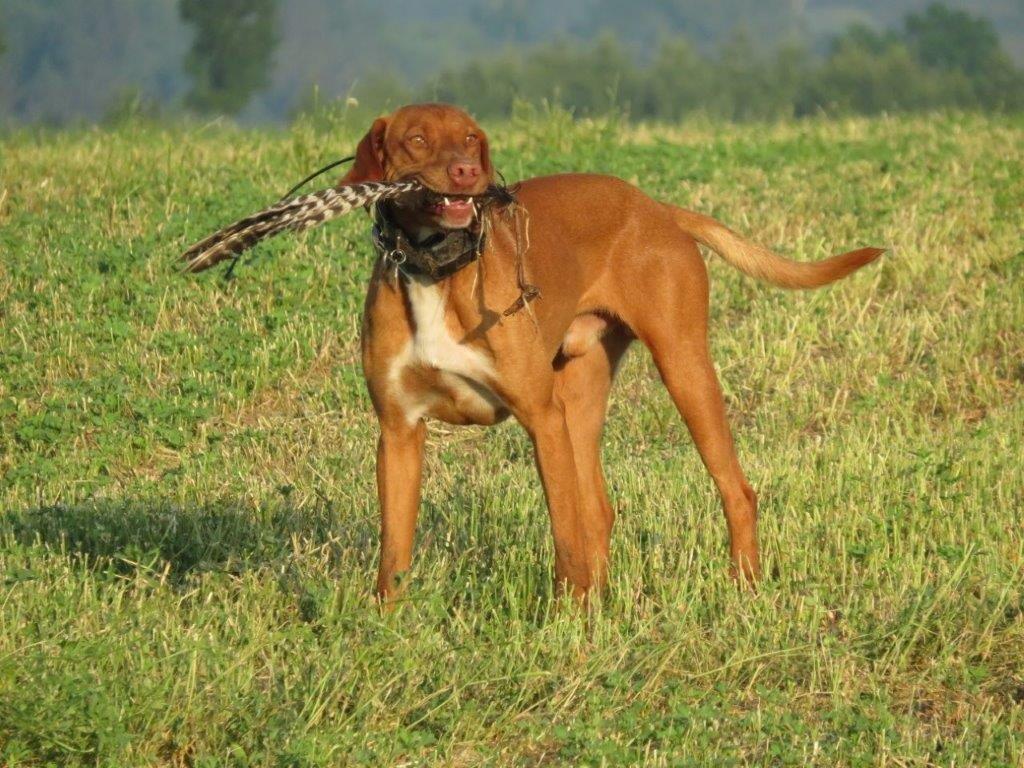 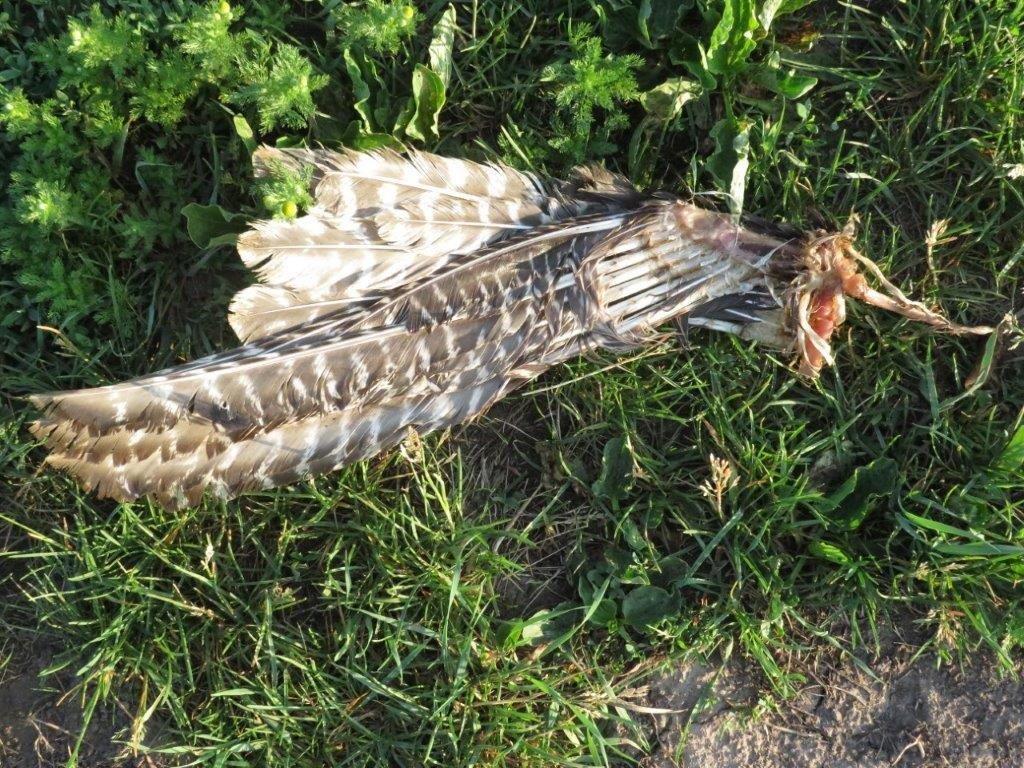 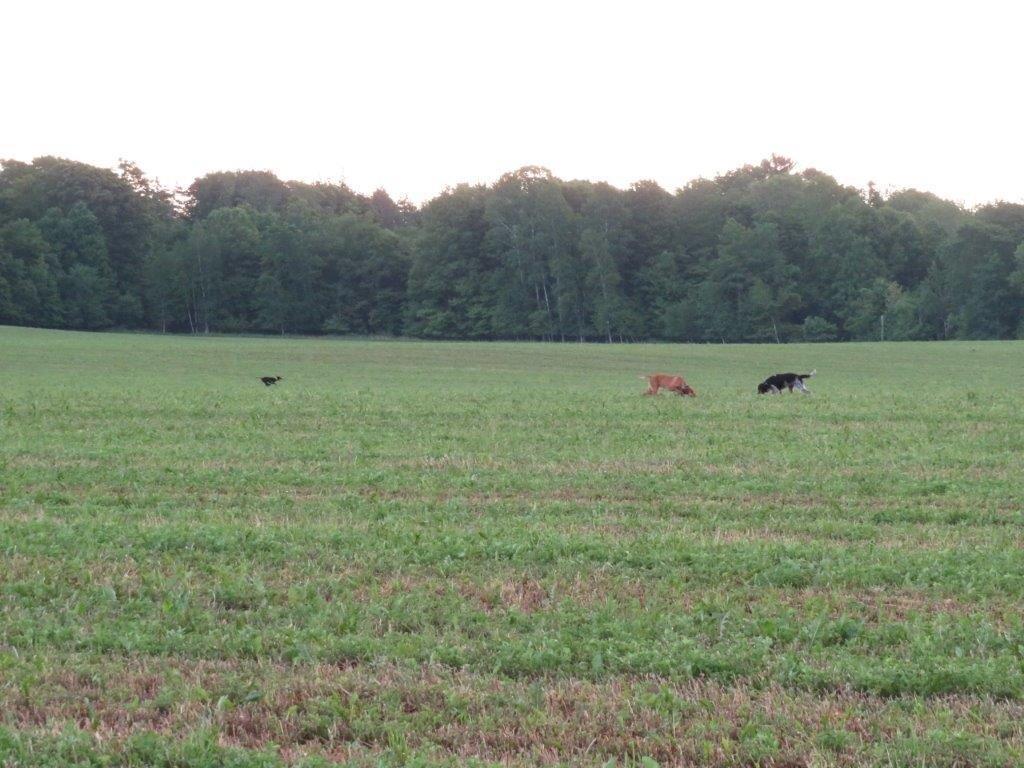 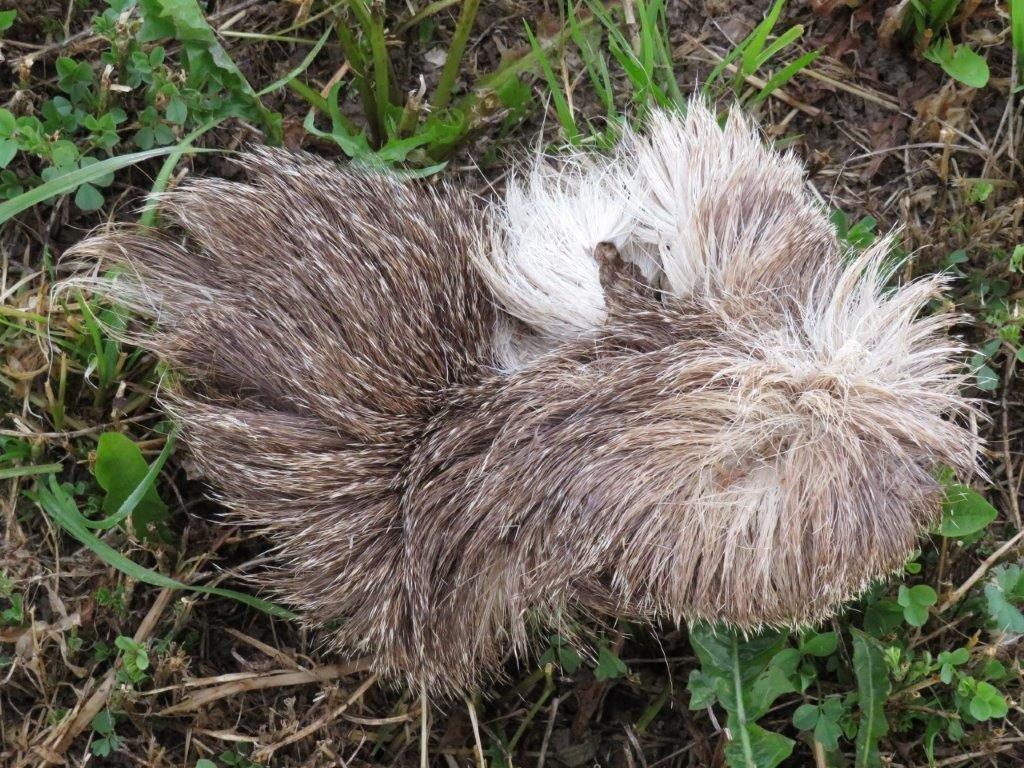 What we need are robot drones with infrared cameras that launch before they mow. Volunteer hunters then clear the field of nesting turkeys and bedded deer for the farmer. This turkey was in a 15 acre field. The deer was in a 60 acre field. Get permission to exercise your dog in freshly cut hayfields, find the remnants and help build the database! Send pictures and data here. For every deer and turkey flushed before mowing, Whitetails Unlimited, Bass Pro Shops, Cabelas, NWTF and the AWTHDA would reimburse farmers for their trouble. If you're reading this and would like to help, send an email. Drone technology has come a long way in the last 6 years, here's from 2015: Drones with infrared cameras save turkeys from harvesters. Perhaps we can incorporate the program into existing agricultural drones. Save the turkeys, save the deer, save farmers having to clean the mower. |
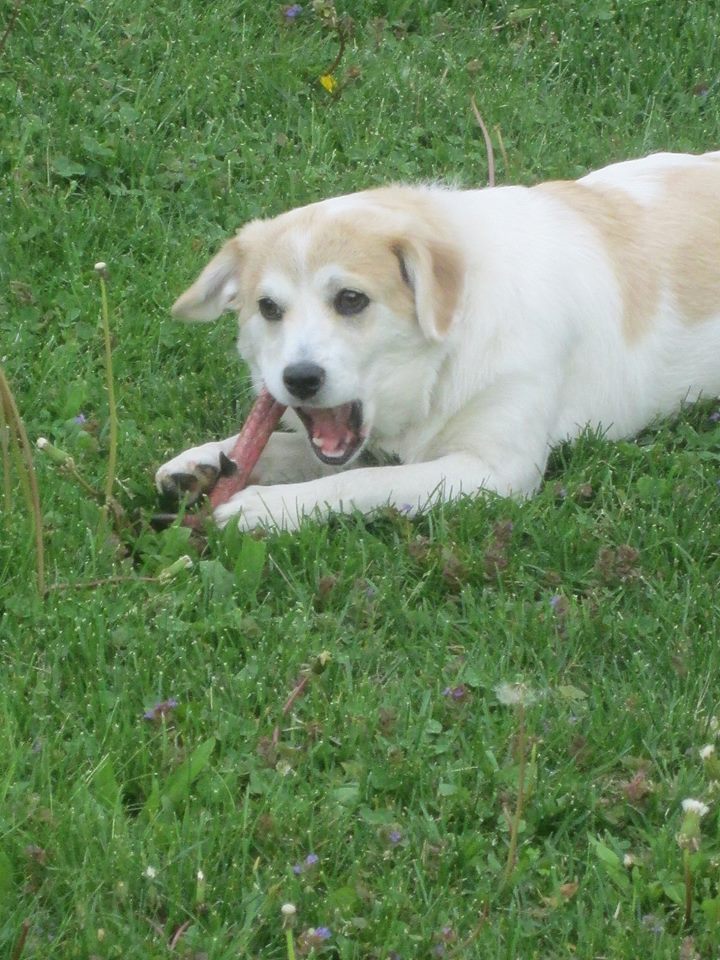 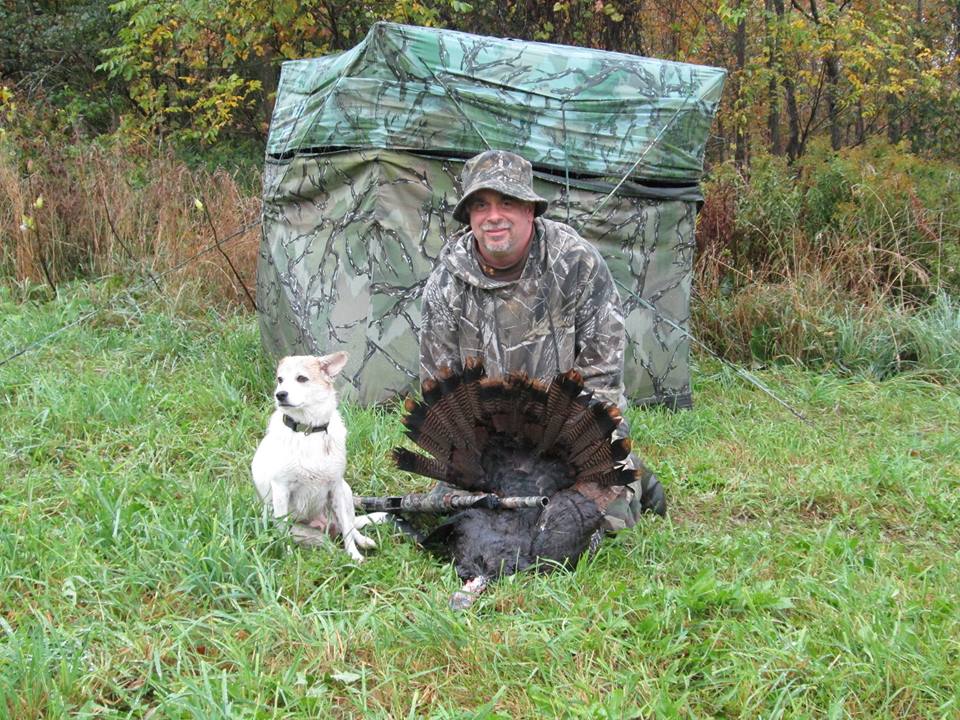 "As
a boy growing up, I enjoyed hunting pheasants and rabbits
with my
father and dogs that he or his friends owned. There were
very few
turkeys around in those days, mostly in the mountains of
Pennsylvania
where we would hunt deer. "As
a boy growing up, I enjoyed hunting pheasants and rabbits
with my
father and dogs that he or his friends owned. There were
very few
turkeys around in those days, mostly in the mountains of
Pennsylvania
where we would hunt deer.I never gave a whole lot of thought to turkey hunting until I bought some land in western NY to use for deer hunting. I often spied turkeys in the woods or fields or bumped them out of their trees, and decided I wanted to learn how to hunt these fascinating birds. 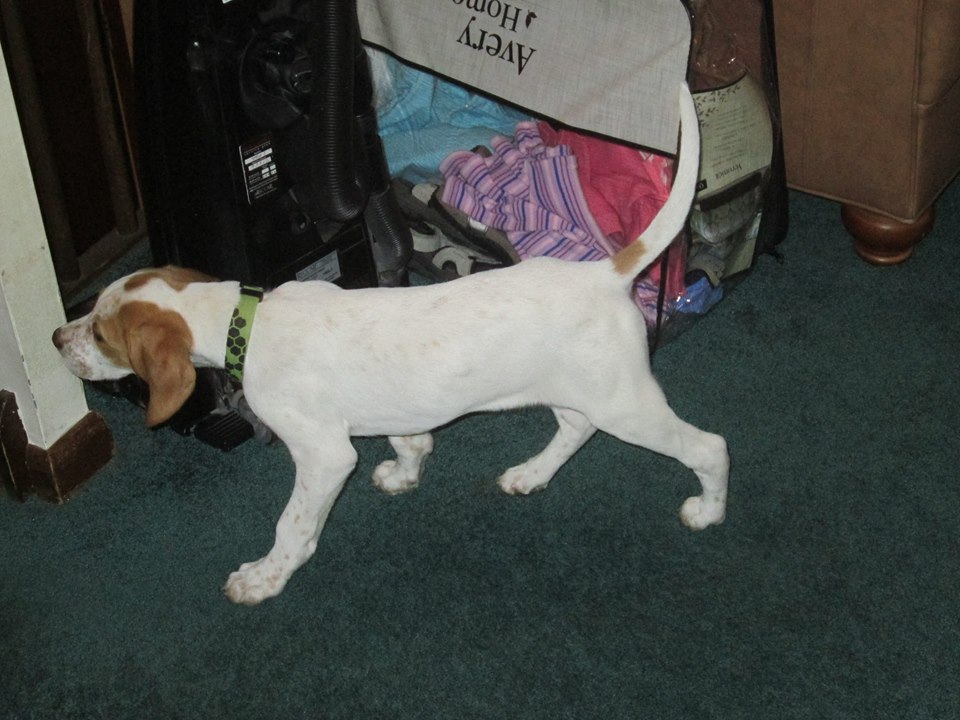  dogs
bust a flock of birds, and the success (and sometimes
disappointment)
of trying to call birds back in after a flush. I also met
up with a
great guide in New York state, Kevin Evans from Turkey
Ridge Raquette,
who had turkey dogs. dogs
bust a flock of birds, and the success (and sometimes
disappointment)
of trying to call birds back in after a flush. I also met
up with a
great guide in New York state, Kevin Evans from Turkey
Ridge Raquette,
who had turkey dogs. Last year, I finally decided to take the plunge on my own, and try to train a turkey dog. I knew this was not going to be easy, because there are not a lot of huntable birds in the corner of Pennsylvania where I live. My first pup Mia was a rescue dog, I was told the dog was some sort of spaniel mixed with Golden Retriever, but after she grew a little, it became obvious I was duped, she’s probably a 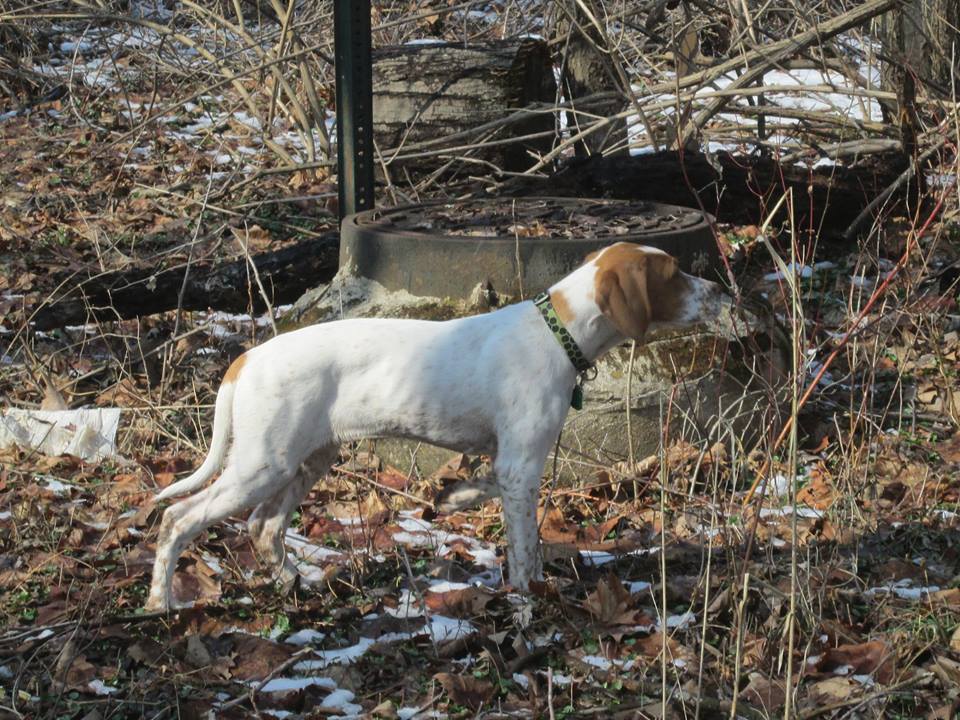 Jack
Russell Terrier mixed with some larger dog. Since she
seemed to Jack
Russell Terrier mixed with some larger dog. Since she
seemed to 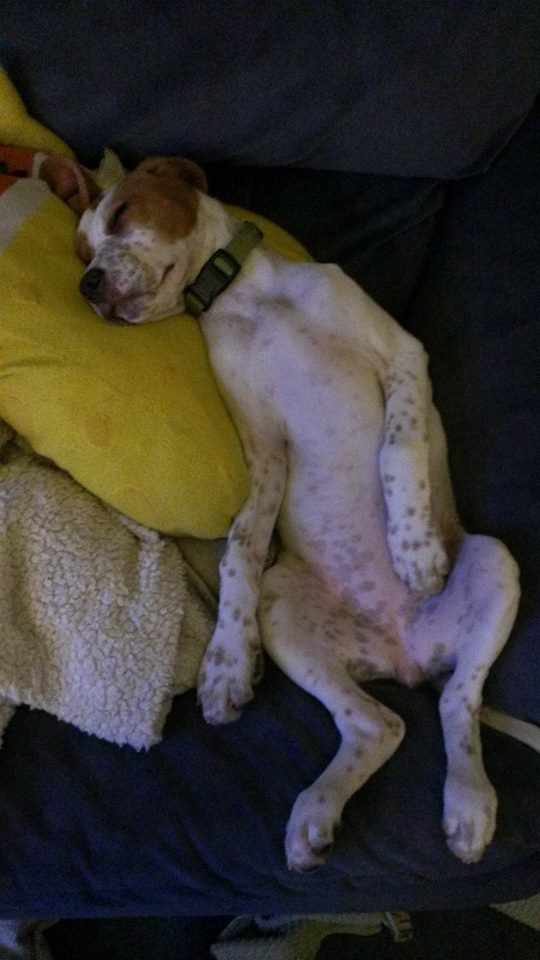 have
a good nose and interest in birds, I spent a lot of times
with her in
the woods and training, but she never really had the drive
that you
need in a hunting dog, so she’s been retired and spends
her days as a
lap dog and burglar/mailman alarm. Here is a picture of
Mia with a fall
bird that I shot last year. have
a good nose and interest in birds, I spent a lot of times
with her in
the woods and training, but she never really had the drive
that you
need in a hunting dog, so she’s been retired and spends
her days as a
lap dog and burglar/mailman alarm. Here is a picture of
Mia with a fall
bird that I shot last year.This year, after a little coaxing from a friend, I decided to go back to the drawing board and start over again. This time I got a bonafide turkey dog, a pointer/setter mix that I got from Mr. Randy Carter in Virginia. 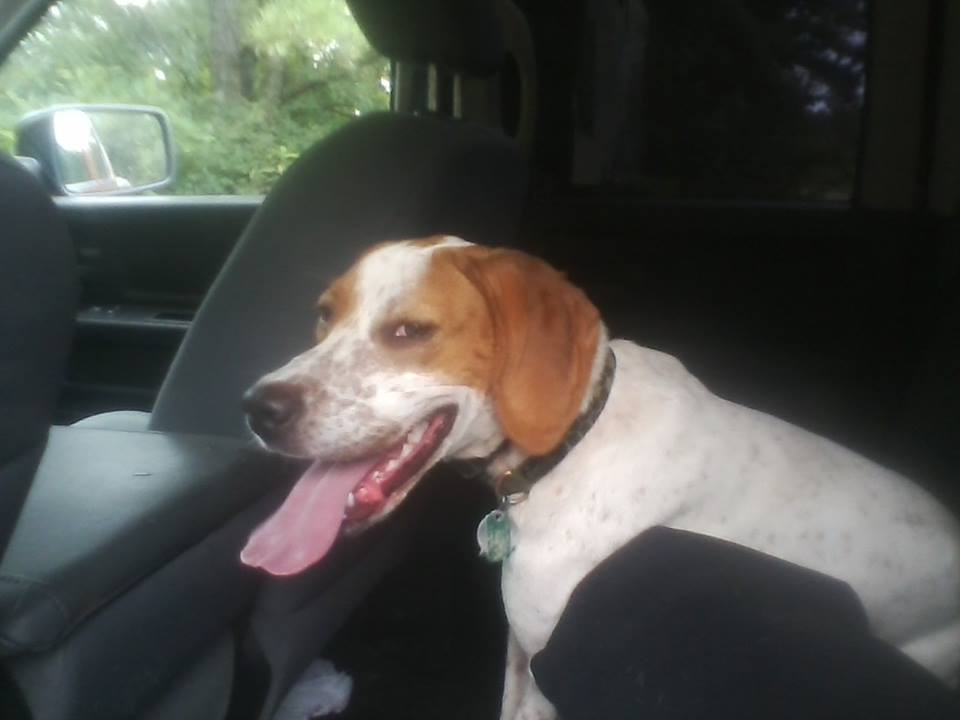 We
called her Maizy, she comes from a long line of successful
turkey dogs.
She has boundless energy, which is great in the woods, but
not so great
in the house, where we keep her. The first 6 months that
we had her I
took her out for numerous long walks in the woods, trained
her in the
yard with turkey wings and dead chukars, and took her a
number of times
to a pheasant farm We
called her Maizy, she comes from a long line of successful
turkey dogs.
She has boundless energy, which is great in the woods, but
not so great
in the house, where we keep her. The first 6 months that
we had her I
took her out for numerous long walks in the woods, trained
her in the
yard with turkey wings and dead chukars, and took her a
number of times
to a pheasant farm  to give
her exposure
to flushing live birds. At 8 months, I sent her to Kevin Evans
to work with his dogs, and he was able to train her on
some more
advanced techniques and she broke flocks multiple times
when she was
with him. to give
her exposure
to flushing live birds. At 8 months, I sent her to Kevin Evans
to work with his dogs, and he was able to train her on
some more
advanced techniques and she broke flocks multiple times
when she was
with him.I am looking forward to hunting with Maizy this fall, she is showing all the signs of becoming a great turkey dog. Because of the conservative fall limits in PA (and starting this year in NY), I am looking into hunting in Virginia this year, where all of this started." Nick Dalasio King of Prussia, PA Sept. 10, 2015 Update October 12,
2015:
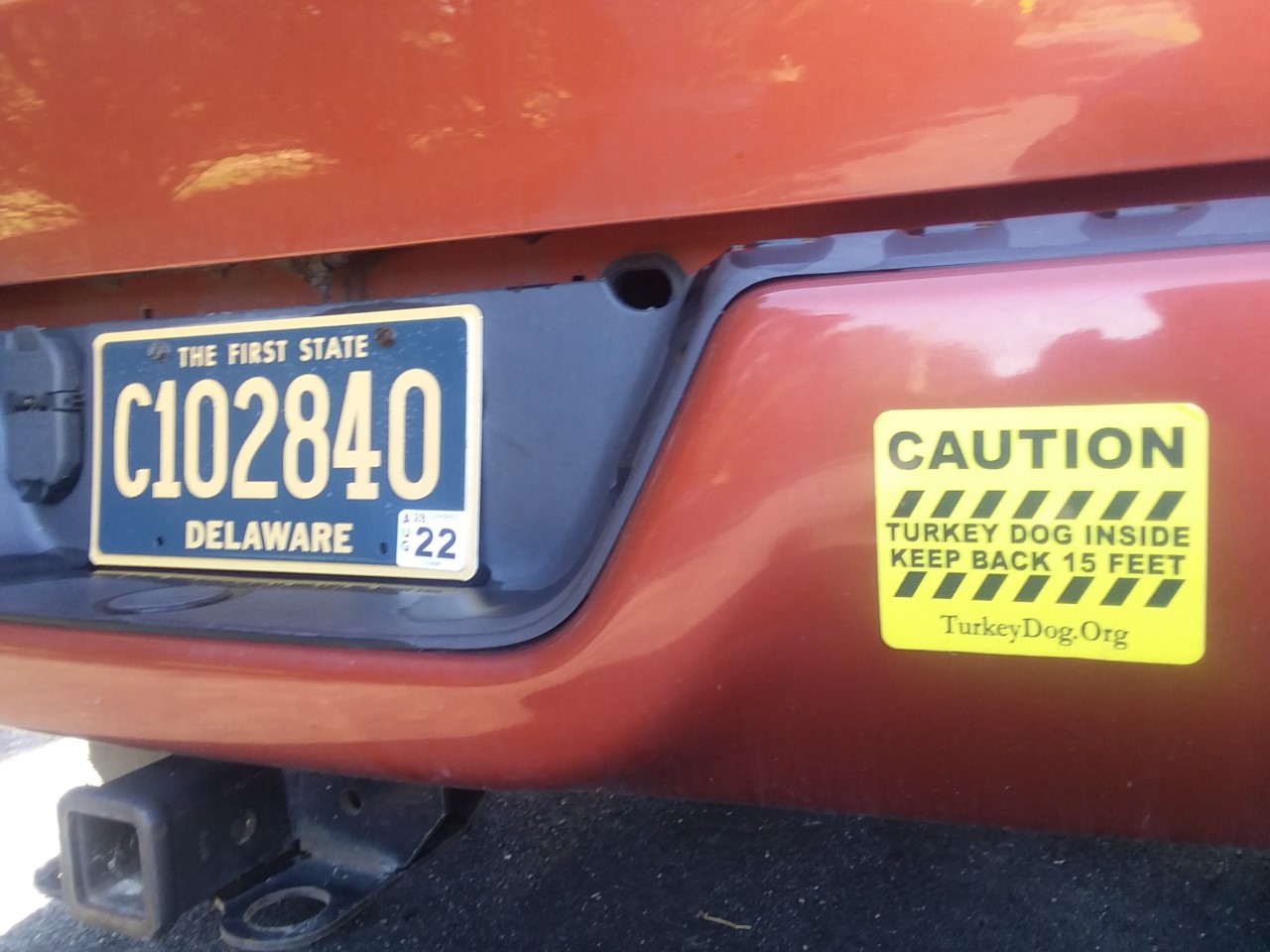 "I had
Maizy
(10 months old) down to Virginia to train with Earl
Sechrist & his dog Patch
(18 months) this weekend. We went to the Quantico marine
base, GREAT
turkey population. Maizy put in 6 hard hours
Saturday, 4
yesterday. She had 7 breaks total, all with a ton of
barking. 4 of the
flushes were within eyesight, 99% sure the other breaks
were turkeys,
not her barking at deer since we saw birds in the trees
afterwards and
were watching her on Earl's GPS system, she was working
the same area
(not heading out in a straight line). She's ranging as far
as 400
yards. I feel this was EXACTLY what she needed, gave me
some piece of
mind as well. Oddly enough, when she gets a good scent,
she'll let out
a couple small barks first, then she's off to the races.
I'm picking up
a GPS collar today, might as well get the best. In for a
penny, in for
a pound." Nick
Dalasio King of Prussia, PA "I had
Maizy
(10 months old) down to Virginia to train with Earl
Sechrist & his dog Patch
(18 months) this weekend. We went to the Quantico marine
base, GREAT
turkey population. Maizy put in 6 hard hours
Saturday, 4
yesterday. She had 7 breaks total, all with a ton of
barking. 4 of the
flushes were within eyesight, 99% sure the other breaks
were turkeys,
not her barking at deer since we saw birds in the trees
afterwards and
were watching her on Earl's GPS system, she was working
the same area
(not heading out in a straight line). She's ranging as far
as 400
yards. I feel this was EXACTLY what she needed, gave me
some piece of
mind as well. Oddly enough, when she gets a good scent,
she'll let out
a couple small barks first, then she's off to the races.
I'm picking up
a GPS collar today, might as well get the best. In for a
penny, in for
a pound." Nick
Dalasio King of Prussia, PAUpdate November 16,
2015:
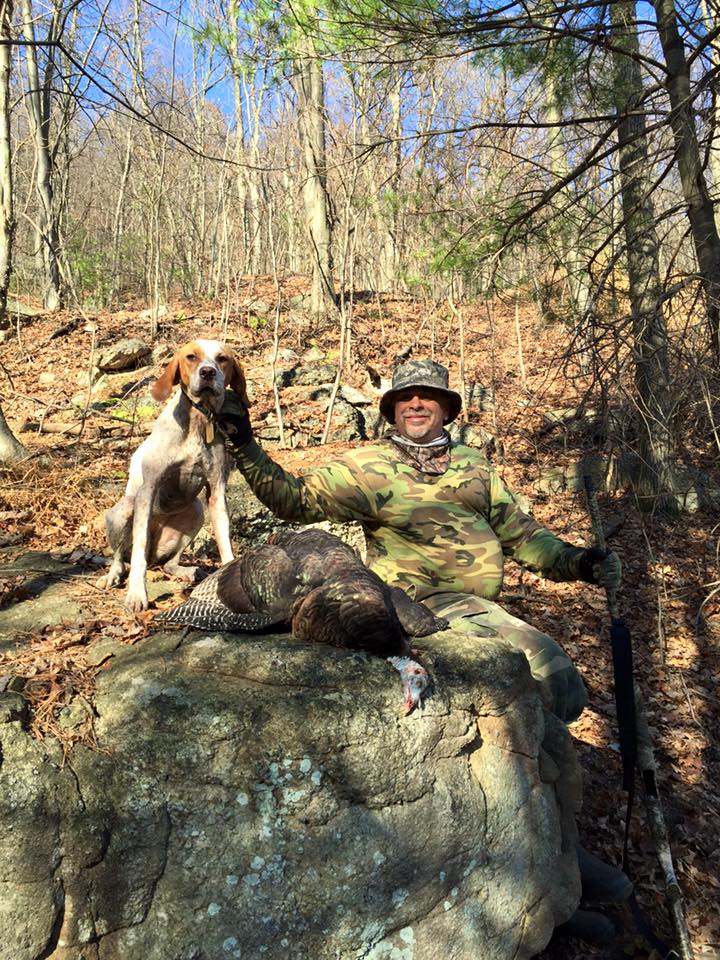 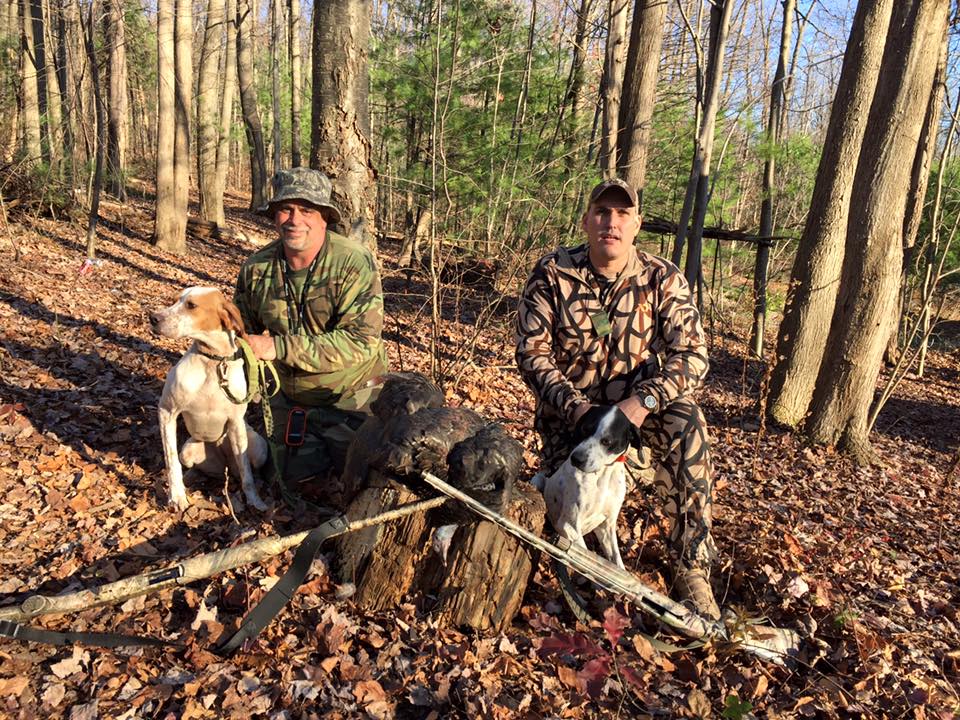 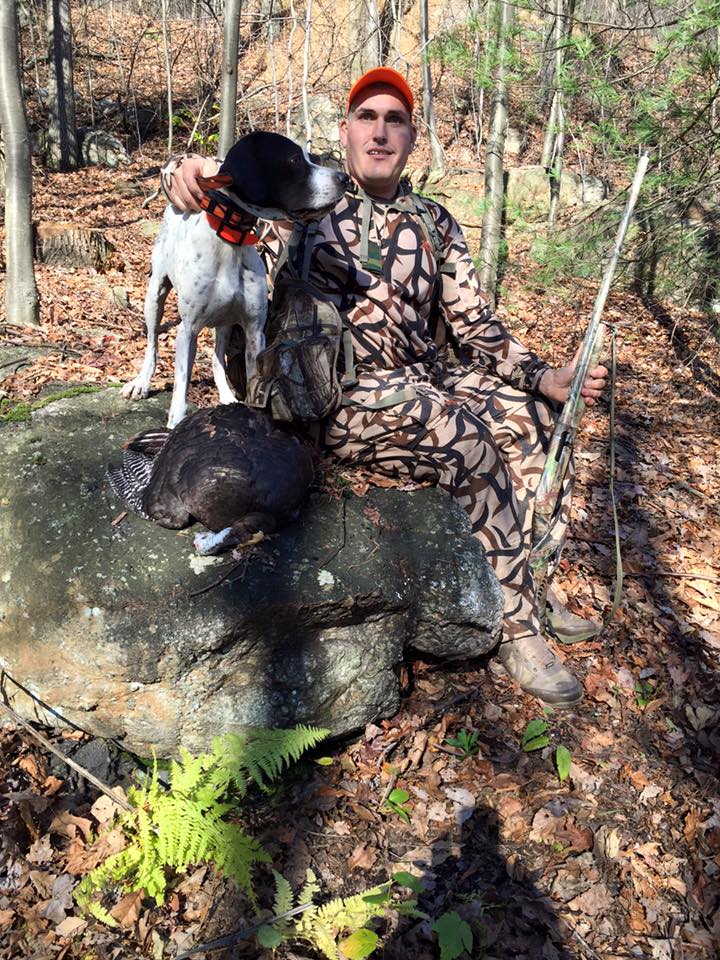 "GREAT
day in the PA turkey woods today. I hunted with Job Seger
and his
Byrne's dog Gunner. Both Gunner and Maizy were in on the
break, Job got
his bird first, and 40 minutes later I killed this
first-year jake.
Maizy sat great for me, and headed straight for the bird
after the
shot. This was my first bird that I killed with Maizy,
we've had a lot
of close calls this fall, but were able to put it all
together today.
SOOO proud of my girl, she keeps getting more confident
each time I
take her in the woods. A day I won't forget for a long
time." Nick "GREAT
day in the PA turkey woods today. I hunted with Job Seger
and his
Byrne's dog Gunner. Both Gunner and Maizy were in on the
break, Job got
his bird first, and 40 minutes later I killed this
first-year jake.
Maizy sat great for me, and headed straight for the bird
after the
shot. This was my first bird that I killed with Maizy,
we've had a lot
of close calls this fall, but were able to put it all
together today.
SOOO proud of my girl, she keeps getting more confident
each time I
take her in the woods. A day I won't forget for a long
time." NickScroll down to the green row near the bottom of this page, to see Gunner 5 years ago, when he was 4 1/2 months old, with his first bird! A couple of great Pennsylvania turkey dogs, carrying on the tradition! |
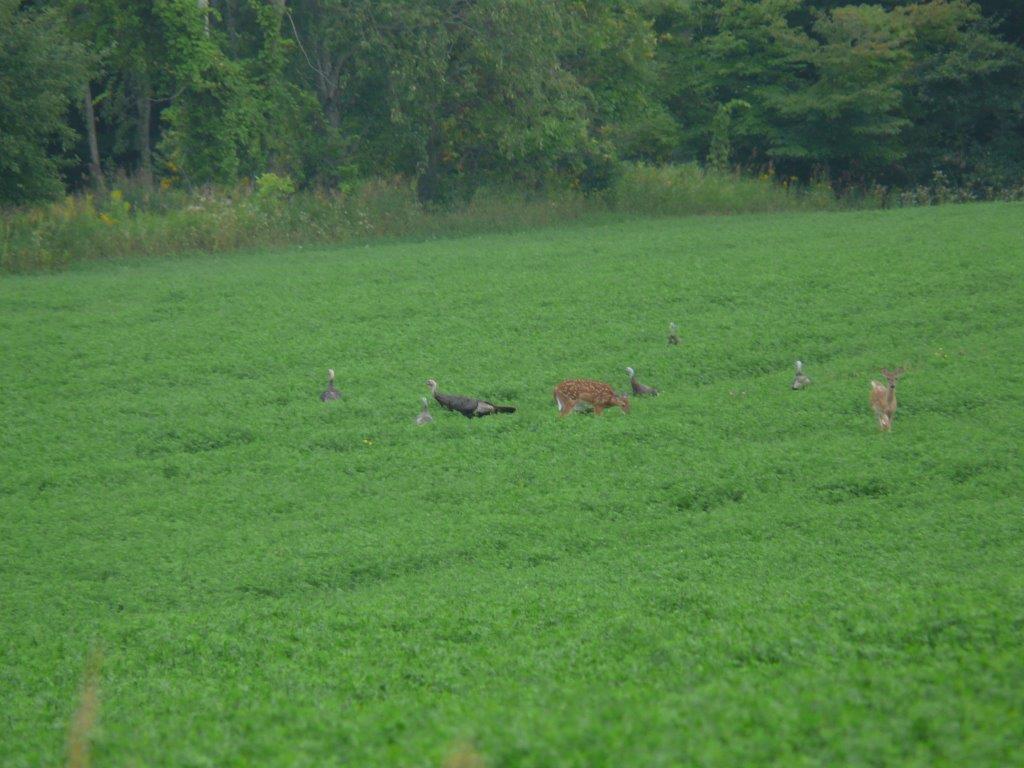 Tisch Mills, WI (AP) -
Husband
& wife archers report failure when deer &
turkeys gang
up for their protection. Exclusive to
TurkeyDog.Org -
9/20/14 Tisch Mills, WI (AP) -
Husband
& wife archers report failure when deer &
turkeys gang
up for their protection. Exclusive to
TurkeyDog.Org -
9/20/14"Turkeys are walking right under the deer, like chickens walk under cows in the barnyard. No fear of each other. They work together now, like one species." 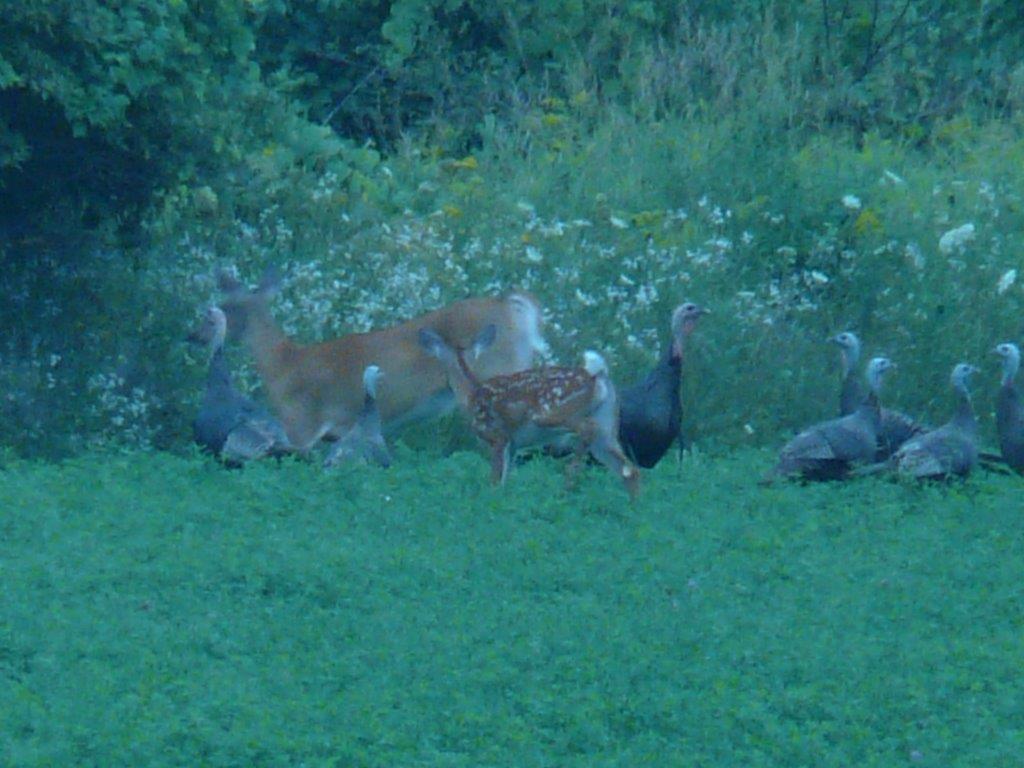 For
years, hunters
have reported deer are getting harder to hunt, because the turkeys warn the
deer,
and vice-versa. After seeing many examples such as;
'football like'
huddles of deer and turkeys (pictures left & right),
to big
bucks that survived the hunting
season (walking single file, hiding in the middle of a
flock of 15
turkeys),
to turkeys walking underneath the deer, by 2014 the symbiosis
is complete. For
years, hunters
have reported deer are getting harder to hunt, because the turkeys warn the
deer,
and vice-versa. After seeing many examples such as;
'football like'
huddles of deer and turkeys (pictures left & right),
to big
bucks that survived the hunting
season (walking single file, hiding in the middle of a
flock of 15
turkeys),
to turkeys walking underneath the deer, by 2014 the symbiosis
is complete. The biologists say it's facultative, not obligate. And the best alternative archers have, is to invite turkey hunters to put the fear of dog into them. Otherwise, because of their affiliation with the turkey lookouts, the big bucks become harder to find. Guaranteed to increase the archer's odds, as the deer's perimeter sentinels will be watching for dogs, instead of deer. 2014 turkeydog.org |
| Here's a
tip
on 3 things to keep stick-tites and burdocks (aka
cockle
burs) from sticking to the hair of Setter type dogs.
(members only). If
you have a long hair dog and have stick-tites or burdocks
where you
hunt, this tip alone is worth the price of membership. |
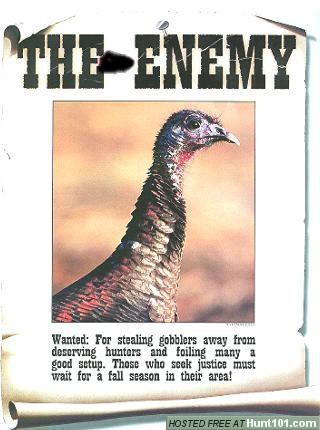 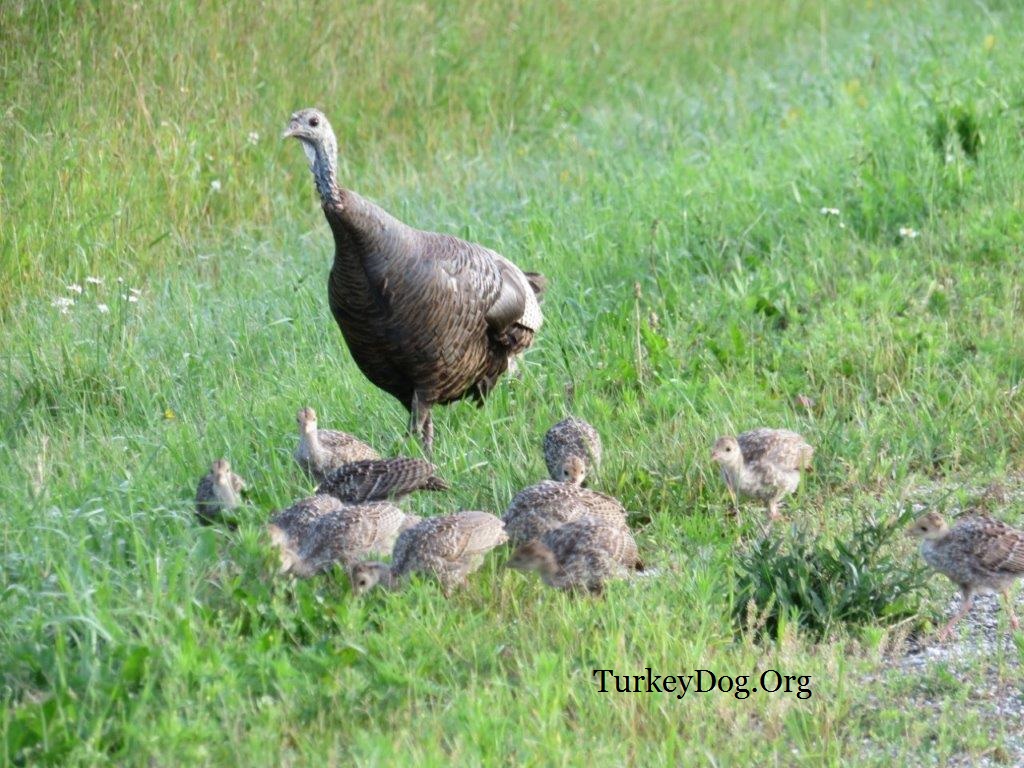 While this picture jokingly
refers to
the hen being the enemy, many turkey hunters (who have
only hunted
spring gobblers), may fail to appreciate the critical
position the hen
has in the flock hierarchy. Except for the spring breeding
season (when
the hens are obviously in command of the toms), and for a
few months in
the Winter, the males never associate with the rest of the
flock, only
with other males. Males are only dominant over other males
and are
rarely dominant over females, except during the brief act
of
copulation. Hunt turkeys in the Fall and you'll find
they're all more
difficult to hunt than a gobbler in the Spring. Hens are
the ones in
charge of the flock's safety all year long. You see that
in the
Springtime, when they order the Toms to follow them
(rather than come
to your call), in the Summertime raising their young, in
the Fall
protecting the family, and in the Winter when the Toms
have joined the
flock. Hens are far more wary and responsible year round.
Especially
more than the gobbler obsessed with just one thing in the
spring, when
you see even old
timers
running
in to the gun While this picture jokingly
refers to
the hen being the enemy, many turkey hunters (who have
only hunted
spring gobblers), may fail to appreciate the critical
position the hen
has in the flock hierarchy. Except for the spring breeding
season (when
the hens are obviously in command of the toms), and for a
few months in
the Winter, the males never associate with the rest of the
flock, only
with other males. Males are only dominant over other males
and are
rarely dominant over females, except during the brief act
of
copulation. Hunt turkeys in the Fall and you'll find
they're all more
difficult to hunt than a gobbler in the Spring. Hens are
the ones in
charge of the flock's safety all year long. You see that
in the
Springtime, when they order the Toms to follow them
(rather than come
to your call), in the Summertime raising their young, in
the Fall
protecting the family, and in the Winter when the Toms
have joined the
flock. Hens are far more wary and responsible year round.
Especially
more than the gobbler obsessed with just one thing in the
spring, when
you see even old
timers
running
in to the gun |
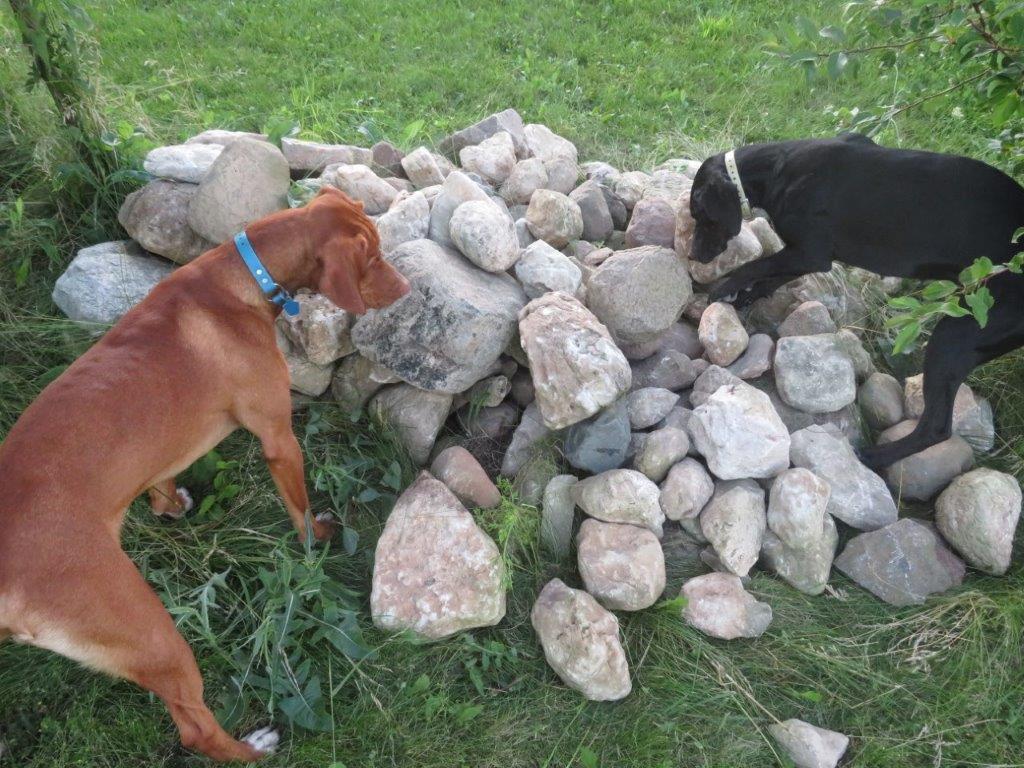 Is
it a struggle to trim your dogs nails? Put a stone pile in
the yard. Is
it a struggle to trim your dogs nails? Put a stone pile in
the yard.Soon enough a mouse or a chipmunk will have your dog doing her own nails. Listen. |
"I
remember a pretty incident in connection with a turkey hen
demonstrating a knowledge of character on her part. I had
taken my
stand on the end of St. Eosas Island, off Pensacola, to
watch for deer
that the hounds were driving. After my arrival a turkey
hen came
skimming to the ground, and presently walked toward a
knoll of grass a
few yards from my place of concealment. Her anxious look
and her
feigned attitude of indifference immediately showed that
she was near
her nest, and taking a pocket spy-glass I carried with me
to watch the
water channels, I presently saw her settle herself down
among some low
willows, until nothing but her head appeared.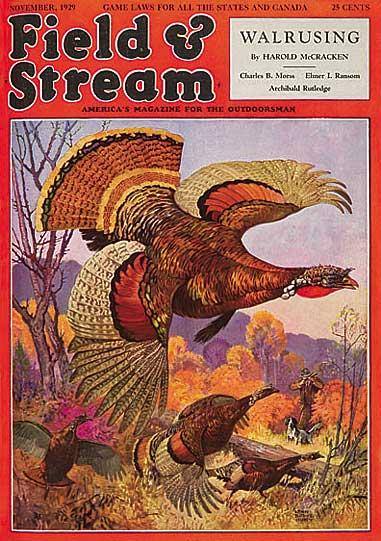 Shortly afterward a
fox
came by, and coming across the trail of the
turkey he turned short about, and throwing up his sharp
nose, scented
the different spears of grass the bird had touched, and
then taking up
her trail, commenced following it slowly and cautiously
toward where
she was sitting. With noiseless foot and undulating body
he wound along
in the trail, when suddenly, to my surprise, I saw the
turkey hen leave
her willow clump, and returning on her own trail, walk
directly toward
the fox. She picked hither and thither, in a nonchalant
manner, and
when within some ten or fifteen yards of her enemy, who
had crouched in
the sparse grass when he first saw her coming, she
diverged slowly to
the right, and the fox, as she turned aside, recommenced
his crawlings,
keeping his eye on the bird and leaving the trail he had
been
previously following. In this way they progressed some
hundred yards in
a direction contrary to her nest, when coming near a low
tree, with a
soft chuckle, which seemed to say, as plain as accent
could make it,
"What a fool you are!" she flitted up in the tree. Shortly afterward a
fox
came by, and coming across the trail of the
turkey he turned short about, and throwing up his sharp
nose, scented
the different spears of grass the bird had touched, and
then taking up
her trail, commenced following it slowly and cautiously
toward where
she was sitting. With noiseless foot and undulating body
he wound along
in the trail, when suddenly, to my surprise, I saw the
turkey hen leave
her willow clump, and returning on her own trail, walk
directly toward
the fox. She picked hither and thither, in a nonchalant
manner, and
when within some ten or fifteen yards of her enemy, who
had crouched in
the sparse grass when he first saw her coming, she
diverged slowly to
the right, and the fox, as she turned aside, recommenced
his crawlings,
keeping his eye on the bird and leaving the trail he had
been
previously following. In this way they progressed some
hundred yards in
a direction contrary to her nest, when coming near a low
tree, with a
soft chuckle, which seemed to say, as plain as accent
could make it,
"What a fool you are!" she flitted up in the tree.The fox being then on open ground, at once knew himself discovered, and rising from his crouching position, after one or two longing looks, and a whimper of disappointment, trotted over the sandhills, and was lost to sight." Camp-fires Of The Everglades, Or, Wild Sports In The South |
125
years
after Whitehead wrote that, we know a lot more. Yet, it's
just
recently realized that most dinosaurs had feathers, not
scales. Despite all the studies, we still don't understand
the mystery
of such phenomenal collective behavior
as how birds and butterlies migrate to somewhere they've
never been,
how schools of fish move as one, how insects swarm, or how
30,000 birds
instantaneously communicate high-speed synchronous murmurations. 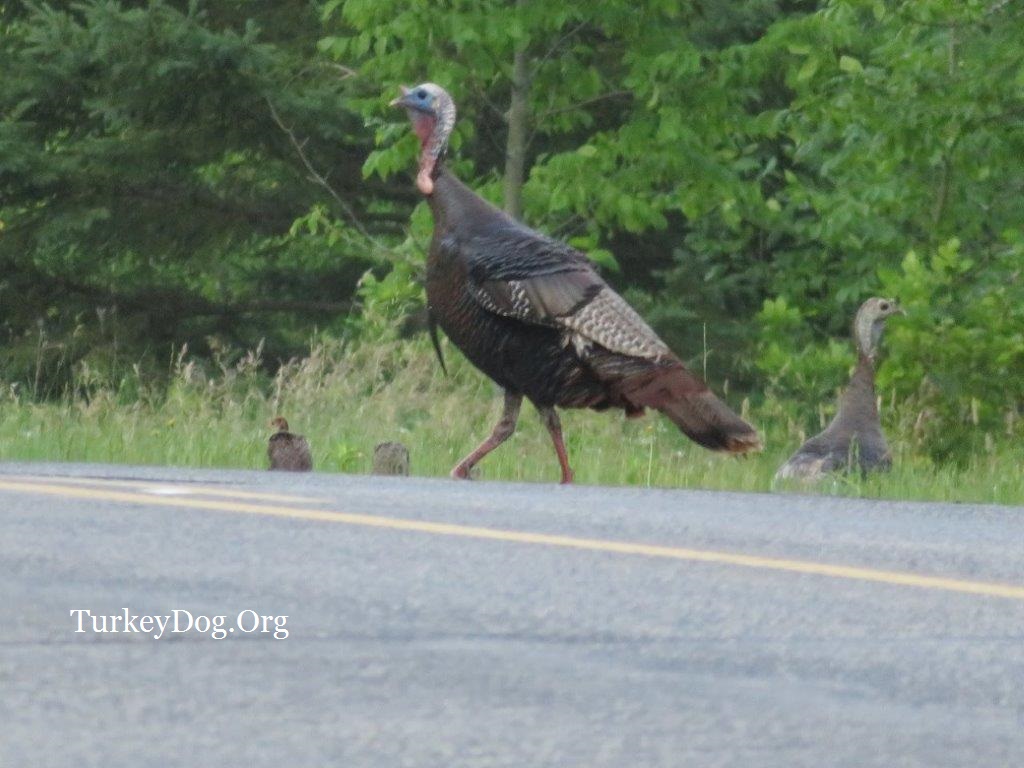 Hunting
in the fall with a dog gives us more insight into the
collective
intelligence, complex cognitive abilities
and defense
mechanisms of wild turkeys, than hunting in spring. In
most of the
country, we are (or recently were) living in the golden
era of turkey
hunting. Hunting
in the fall with a dog gives us more insight into the
collective
intelligence, complex cognitive abilities
and defense
mechanisms of wild turkeys, than hunting in spring. In
most of the
country, we are (or recently were) living in the golden
era of turkey
hunting. Is the aggregate knowledge of older, experienced turkeys critical to survival of the flock? Is spring gobbler hunting and the accompanying loss of flock intelligence responsible for the population decline in some states? How many genetic diversity studies have ever been done? Should we only hunt them in fall again, when the entire flock has their wits about them? For centuries hunters decoded every call of the wild turkey. It's easier to fool a sex-crazed male accompanied by a hen or two in the spring, than to fool a much bigger flock in the fall. Does a hen struggle more to protect her offspring, without the biggest, most aggressive, eldest gobblers off in the distance, alerting to danger? The starlings involved in the murmuration video above have declined in the last 40 years in Europe by 70%. Protecting habitat is just part of the answer. The revenue from spring turkey hunting is addicting. Heath hens and passenger pigeons dwindled slowly at first too. |
This morning we went for a walk in 3" of fresh snow and Kee-Kee's good nose found turkey tracks right off the bat! We never did actually see them, but thought we heard them putting and calling. I was VERY pleased with this mornings events, this could get addicting very quickly. Good thing we were only out for a walk, because in WV and VA you can only train turkey dogs during the actual hunting season. Once Kee-Kee understands the rule book we'll have it made. Todd 3/13/09 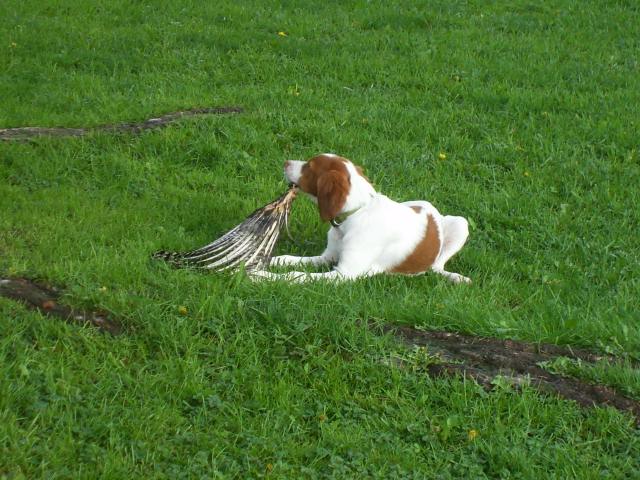 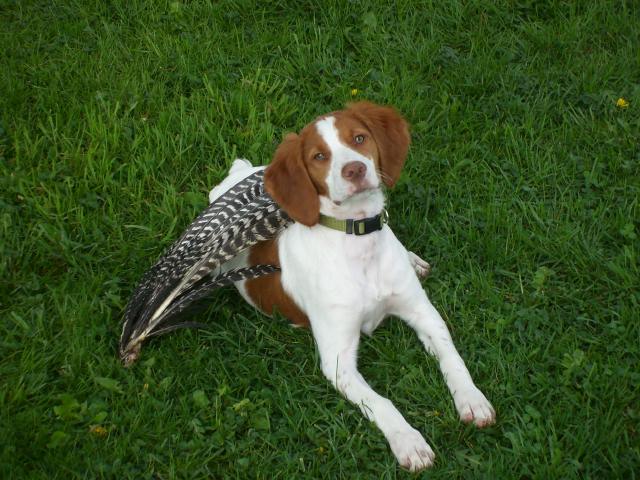 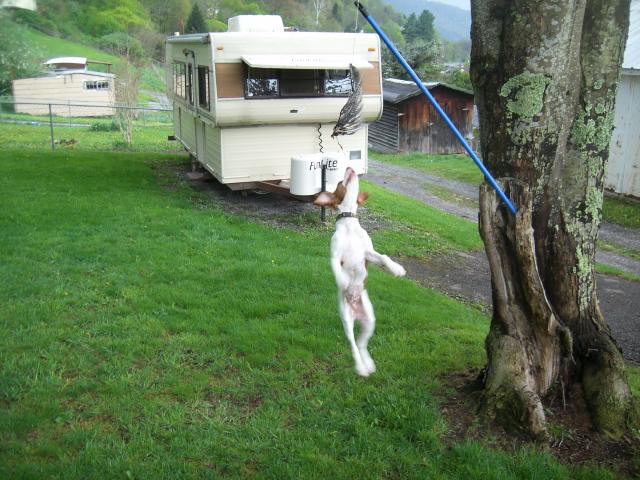  Here's some new pictures of Kee-Kee, she weighs about 21 lbs. now. The ones where she's laying down, I make her stay, and run the wing over her, until I tell her to get it. The ones with the wing in the air she is barking and leaping after it. Todd 4/30/09 |
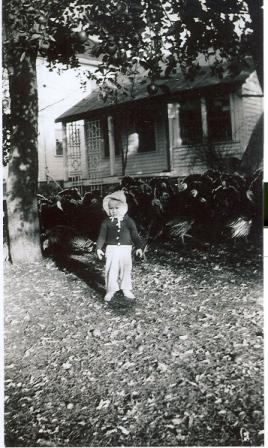 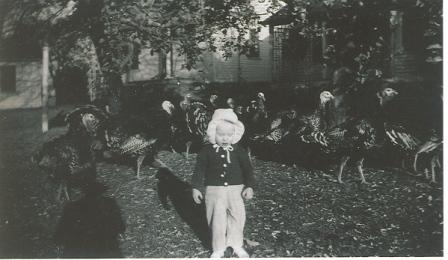 "I
found
these
pictures
of
me
with
Grandpa's
turkeys,
from
the
fall
of
1944
or
1945.
Mom always worryied about me being out and about with the
"flock", but I never had any fear. I remember helping
butcher the
turkeys, they were hung upside down in the barn while we
plucked the
feathers, and I got a quarter a day! These pictures show
the old summer
kitchen (now long gone), to the right of the main
farmhouse, with all
the apple trees in front." Mary Ann S. - Kiel WI "I
found
these
pictures
of
me
with
Grandpa's
turkeys,
from
the
fall
of
1944
or
1945.
Mom always worryied about me being out and about with the
"flock", but I never had any fear. I remember helping
butcher the
turkeys, they were hung upside down in the barn while we
plucked the
feathers, and I got a quarter a day! These pictures show
the old summer
kitchen (now long gone), to the right of the main
farmhouse, with all
the apple trees in front." Mary Ann S. - Kiel WI |
"The turkey's closest living relatives are the Asian pheasant and the African guinea fowl. The American turkey and the Asian pheasant are close enough genetically so that they can be mated through artificial insemination and produce offspring." Did you know the word 'gobble' used to describe the sound has been in the Oxford Dictionary since 1680? And like some lizards and snakes, the turkey hen has the ability to reproduce by parthenogenesis (without the gobbler). The Turkey: An American Story. |
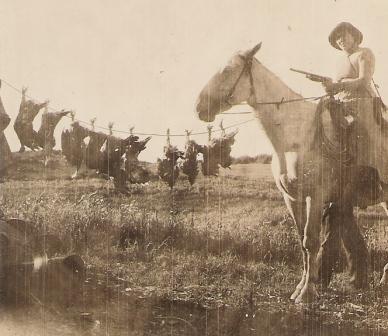 "Until dogs
are allowed in the whole
state we use a different method. We lead a team of plow
horses at an
angle right up to the turkeys, let go of the halters,
stop, and let the
horses keep walking. When the horses get past the hunter,
the turkeys
are caught flat-footed; boom! The key is making sure their
kick can't
reach you when the gun goes off. We call them our Turkey Horses."
David Edge - White Lake, WI "Until dogs
are allowed in the whole
state we use a different method. We lead a team of plow
horses at an
angle right up to the turkeys, let go of the halters,
stop, and let the
horses keep walking. When the horses get past the hunter,
the turkeys
are caught flat-footed; boom! The key is making sure their
kick can't
reach you when the gun goes off. We call them our Turkey Horses."
David Edge - White Lake, WI |
|
The Chief Biologist
from Virginia said:
'In every state you look at, hunter effort for fall
turkeys is
declining.' That's the same story heard in Wisconsin,
and West
Virginia. And again in Virginia.
"It could be true considering the fall tradition has been nearly lost, and many hunters don't know how to use a dog. There's a misconception turkey dogs are wide ranging. But in today's urban landscape, and at my age, the close working dog suits me fine. How much interest would there be in pheasant or grouse hunting if you couldn't use a dog? Fall turkey hunting is no different. It can be done alone, but it's always more fun hunting birds with a dog. The only game more challenging to hunt than fall gobblers is sheep and goats, that's for sure. The archers who hesitate to run through the woods chasing turkeys with a quiver full of broadheads can particularly benefit from a trained dog breaking up the flock, so they can call the bir Surveys indicate we are a dying breed, and show a decline in both the total number of hunters and the total amount spent by hunters. Overall participation dropped 4% from 2001 to 2006, and 10% from 1996 to 2006. Who's going to fund our wildlife management and Fish & Game budgets? From the 2006 National Survey of Fishing, Hunting, and Wildlife-Associated Recreation. |
| In
the 1960's, Pennsylvania State University researchers
conducted
experiments
to determine the minimum stimulus it takes to excite a
male
turkey, utilizing a model hen. When they removed parts of
the model,
including the tail, feet and wings, the male still
continued to gobble
and mate. All the male needs is a wooden turkey head on a
stick for the
gobbler to become aroused and mount. Next time you wonder
if your
calling & decoy are good enough for spring gobblers,
remember
the head
on a stick. "Back when turkey decoys were illegal in Alabama, the alternative was the old coke can on a stick." Ralph Scherffius 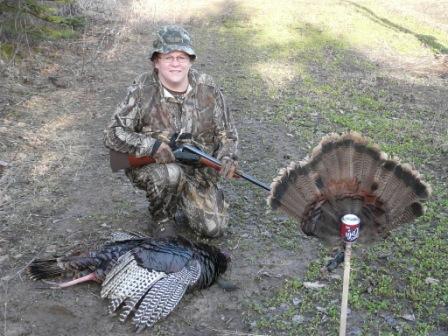 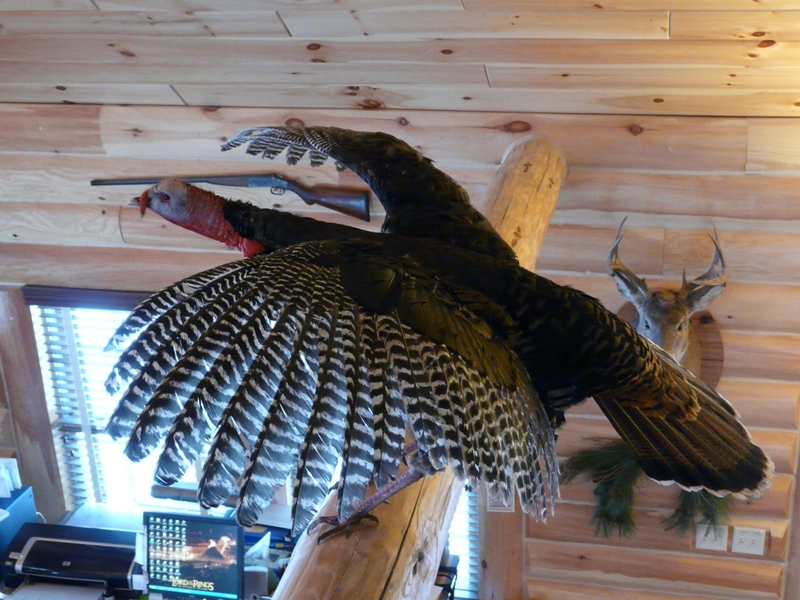 "After
reading about this enticing
research, I decided to try a homemade stick decoy. I used
a jake fan
and a small red soda can and rubbed the stick in the mud
to dull it up
a bit. The first morning I put it out, a double bearded
gobbler walked
in to my tail on a stick, eyeing it the whole time, and
stopping to
strut occasionally, until he got close enough to my 20
gage. I know it
works, picture attached. 7AM 4/17/08 2 beards 10” &
4”, 18
lbs., 1” spurs. The mount depicts his last wing flap as he
flew
down. Patty N. WI "After
reading about this enticing
research, I decided to try a homemade stick decoy. I used
a jake fan
and a small red soda can and rubbed the stick in the mud
to dull it up
a bit. The first morning I put it out, a double bearded
gobbler walked
in to my tail on a stick, eyeing it the whole time, and
stopping to
strut occasionally, until he got close enough to my 20
gage. I know it
works, picture attached. 7AM 4/17/08 2 beards 10” &
4”, 18
lbs., 1” spurs. The mount depicts his last wing flap as he
flew
down. Patty N. WI Thanks for loaning me your decoy, Patty. This grey-phased bearded hen heard our calling, then saw your homemade decoy, and walked right in. When we prepared the meat for my favorite turkey jerky, we found she was the fattest bird we had ever seen in spring! Apparently she didn't waste energy mating or nesting, so everything she ate went right into fat. Thanks again for the decoy that helped me get this unusual bird. I'll use her white-tipped tail fan for my own decoy and see how that works. Aaron F. Madison WI 5/08 |
|
Home | About
Us
|
Books
|
Breeds
| Classifieds
| FAQ
|
History
| Kit
Shaffer
Legislation | Links | Scratchings | Spring | Stories | Tales | Shop in the Store Members are invited to send pictures of yourself and your dog, with a short story like these: Carson Quarles | Earl Sechrist | Frederick Payne 1 | Frederick Payne 2 | Gary Perlstein | Gratten Hepler | Jon Freis 1 | Jon Freis 2 | Larry Case | Marlin Watkins 1 | Marlin Watkins 2 | Mike Joyner | Mike Morrell | Parker Whedon | Randy Carter | Ron Meek 1 | Ron Meek 2 | Tom McMurray | Tommy Barham 1 | Tommy Barham 2 Members Only: Hall of Fame | Members | Museum | Studies | and the States KY | NC | NY | OH | ON | PA | TN | VA | WI | WV 2006 - 2025 American Wild Turkey Hunting Dog Association All Rights Reserved Permission to copy without written authorization is expressly denied. |
